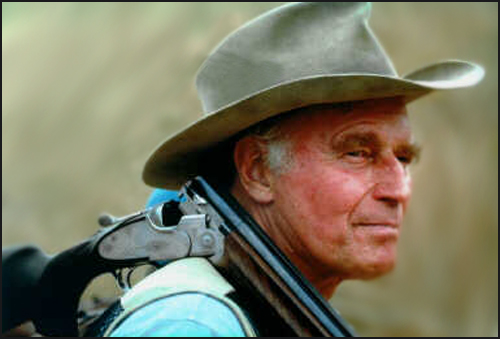John Carter of Earth
Friday, April 11, 2008
posted by Steve Tompkins
 Print This Post
Print This Post

Any given year is a demonstration of mortality in action, but so far 2008 has been especially hellbent on inaugurating the afterlives of figures who had permanent luxury suites in the Tompkinsian pantheon: George MacDonald Fraser, Arthur C. Clarke, Robert Fagles, and now Charlton Heston.
No sooner was I surfing the first wave of obituaries and career summaries than I was muttering and cursing. Everything else Heston did was being reduced to flotsam bobbing atop each half of the parted Red Sea, or dust beneath Judah Ben-Hur’s chariot wheels. It’s difficult to be objective about those movies because they became the Easter season equivalent of the Yule log, always on the TV screen in the background. When I try to watch either, it isn’t long before I wish someone had spiked the holy water. Oh, Ben-Hur retains some interest because of the involvement of Gore Vidal, Yakima Canutt, and a young assistant director named Sergio Leone, and the early scenes at the Egyptian court in The Ten Commandments are entertaining, mostly because of Yul Brynner’s seething Ramses (had he not gotten all that emoting out of his system, would he ever have been able to play the robot gunfighter in Westworld?) But I prefer Heston’s mid-career parts, when cracks in the Michelangelo-sculpted marble and verdigris on the gleaming bronze began to be detectable, so I was glad to find Manohla Dargis’ “The Man Who Touched Evil and Saved the World” in the New York Times: “My fondness for Mr. Heston can be traced back to the films I saw growing up, most important, his great dystopian trilogy, Planet of the Apes (1968), The Omega Man (1971), and Soylent Green (1973).” Had Ms. Dargis bethought her of how Beneath the Planet of the Apes (1970) ends, she might have reconsidered the second half of her tribute’s title, but I’m with her on the Dominus of Dystopia; whenever I read Howard’s “The Last Laugh” (an overheated discussion of which concludes an essay printed in TC V5n1), despite the probable Conanomorphism of the protagonist’s appearance, I imagine Charlton Heston, the last word in last stands and the first choice for the day after the end of the world.

When one is christened John Carter, as was Heston in Illinois, in 1923, a destiny that includes swordplay and striding across science fictional stages is preordained. He never really played a Howard-style barbarian (perhaps a not-so-small mercy, given the heinous crime-against-casting that was John Wayne as Genghiz Khan), although he battled barbaric Frisian raiders in The War Lord (1965)–one can make a case for REH succeeding as a screenwriter strictly on the basis of Chrysagon De la Croix’s calling his sword a “cold wife”–and Natohkian, mostly Berber hordes in El Cid (1961). The historical and science fiction genres afforded him an imaginative depth that offset a supposedly curtailed breadth, but then Mick LaSalle, writing in the San Francisco Chronicle, has beaten me to questioning the attribution of a “limited range” to Heston:
Al Pacino, for example, railing on the beach at the end of Planet of the Apes, would simply register as Al Pacino, very upset. It would most certainly not register as humanity encountering the tragic folly of its ways, but that’s exactly what you get from Heston.
People who think they’ve said it all by typing the words “limited range” deserve to be Soylent Green. Such assessments are the preferred ploy for dismissing the range within which iconic actors or writers excel; witness our reason for blogging here. Okay, Clint Eastwood didn’t really have the range to play John Huston, but it was and is riveting to watch him try in White Hunter Black Heart. Heston won a lot of roles by winning the genetic lottery first, with his profile not unlike that of The Muppet Show’s Sam the Eagle, his lean-hipped, built-to-escape-Ape-City physique and a voice equipped with non-electronic Dolbysound. Martin Scorsese, in his two-page introduction to the staggeringly lavish Collector’s Edition of El Cid released by gruesome twosome Harvey and Bob Weinstein this winter, remarks on the actor’s “unique presence’ derived from “a sense of stillness and of dynamic movement.” Michel Mourlet was already onto this aspect of Heston well before Colonel George Taylor, Chinese Gordon and Will Penny back in 1960:
He constitutes a tragedy in himself…Through him, mise en scene can confront the most intense of conflicts and settle them with the contempt of a god imprisoned, quivering with rage.
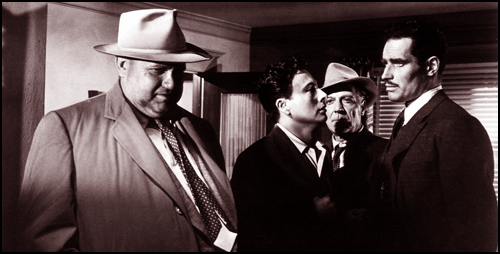
Mourlet famously pronounced Heston “an axiom”; is it any wonder that late in life the actor at times seemed to be embodying not human characters but rather the Second Amendment, the Laffer Curve, and the Supreme Court’s Bush v. Gore decision? Less flippantly, Heston could play troubled men, but they had to be greatly troubled. When he wrestled with doubt, it was on a scale to dwarf any contretemps confected by the WWF. Heston’s casting in Touch of Evil (1958) as Ramon Miguel Vargas, a Mexican cop so upright he makes other law enforcement personnel seem barely bipedal, has been mocked in Get Shorty and Ed Wood, and it’s true that he fails to persuade us that so much as a single ancestor ever spoke Spanish, let alone Nahuatl, but his south-of-the-border straight arrow emphasizes how marvelously bent Orson Welles’ Hank Quinlan is. And it is here, amidst the stews and sinkholes of Quinlan’s corruption, that the demigod-gaze is perturbed by the first intimations that will lead to the immortal bellowing of the words “It’s a madhouse! A madhouse!” No Heston, no Touch of Evil, so it’s gratifying that he was still of sound, if heavily armed, mind and body for the more Wellesian restoration of the film in 1998. Similarly, no Heston, no Major Dundee (another film in which crossing the border is an act of ontological profundity), which might not strike us as a comparable loss unless we factor in the lessons Peckinpah learned and applied to The Wild Bunch.
Anthony Mann was fresh from having been booted from Spartacus when he directed El Cid; “Inside this angry man, there is an artist struggling to get out,” was Heston’s impression of the director. Of course the artist had already achieved breakouts in his Jimmy Stewart Westerns and Man of the West (1958); Mann specialized in tortured psyches externalized topographically, and his sensibility–Mitteleuropa by way of Broadway, the Old World returned to by way of the Old West–is crucial to the continued watchability of El Cid (JFK apparently enjoyed the film so much he invited Heston to the White House and impressed the actor with his knowlege of the Reconquista and Cid-ology).
For Scorsese, the film stands out due to “unusually dark textures,” and heralds a transition from “studio era decorum to a greater frankness,” but unfortunately El Cid too often keeps to the circumspect side of the changeover. With the exception of a minor villain’s redemptory crucifixion at the hands of the North African invaders, the violence is all-but-bloodless; the ocular daggers Sophia Loren and Heston shoot at each other must be the sharpest weapons in the film. And a major opportunity is lost when the “Spanish” Moors, the warriors of Al-Andalus who side with the Cid, are lost in the crowd. This judgement may be unduly influenced by Guy Gavriel Kay’s luminous 1995 novel The Lions of Al-Rassan; Kay telescopes the long, arduous centuries of real-world Spain’s Reconquista into a single lifetime, that shared by his Cid-surrogate Rodrigo Belmonte and the “Moorish” champion Ammar ibn Khairan who is his mirror-image, sword-brother, and cruelly fated ultimate opponent. The film’s emir Moutamin (Douglas Wilmer) suggests an embryonic ibn Khairan, and the character deserved more scenes. On the other hand, the goings-on are enlivened by the Castilian princeling-and-princess Alfonso and Urraca (John Fraser and Genevieve Page), siblings whose closeness possibly explains some things about medieval Spanish royalty.
Chief among the delights of the new ‘Miriam Collection” El Cid package are a featurette about Anthony Mann with actual interview footage, a commentary by the producer’s son and a biographer that delves into the tricky relationship between the Franco dictatorship and the filmmakers–after all, the generalissimo was himself a conqueror who’d landed on Spanish shores with Moorish soldiers–and a reproduction of the 1961 souvenir program that kicks off with an article by none other than Harold Lamb, introduced as “famous Author and Historian.”
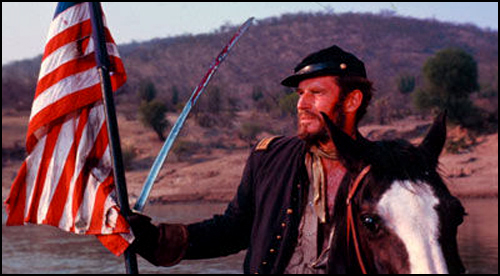
55 Days at Peking is a tougher sell, being more concerned with Marine major Heston’s efforts to disarm estrogen bomb Ava Gardner than with the day-to-day progression of the 1900 siege of the foreign legations’ compound (a mere wall-and-gate away from the Forbidden City). Flora Robson as the Dowager Empress Tzu Hsi, Leo Genn as Jung-Lu, Robert Helpmann as Prince Tuan–all are about as authentic as Duke Feng in de Camp and Carter’s “The Curse of the Monolith.” (Amusingly, the DVD offers subtitles in “traditional Chinese” and “simplified Chinese”) And the movie doesn’t take the time to create even one Boxer character! The Sand Pebbles (either Richard McKenna’s 1962 novel or Robert Wise’s 1966 film) does a much better job of showing the affronts to Chinese sovereignty that would fuel the rival fires of Kuomingtang and Communist nationalism, although Tsui Hark riffed on the opening scene of 55 Days, during which the longsuffering Chinese citizenry must endure the din of the contending anthems of the trespassing nations, as performed by a military band in front of each legation, in Once Upon a Time in China. David Niven’s British envoy refers to “the eleven great powers”–a multipolar world indeed!–and from an American perspective the Boxer Rebellion, even when superficially treated as here, is fascinating because at the dawn of the century, in an enclosed space, we fought side by side with not only our allies in wars yet to come (the British, the French), but also our foes (the Germans, the Austrians, the Italians, the Japanese) and of course our eventual archrival the Russians. 55 Days exhibits none of the Prussophobia that for decades has had many of us chanting “Shoot the German! Shoot the German!” at the climax of The Wild Bunch, and I note with bemusement that Leutnant Georg Ritter Von Trapp (yes, that Von Trapp) was decorated for bravery as part of the Austro-Hungarian naval contingent operating against the Boxers; perhaps he steeled himself for dealing with Julie Andrews by looking back on his Rebellion experiences.
The first element of the multinational relief force to hove into view is the Raj on horseback, Indian cavalry, and a moment or two later hindsight ensures that it’s difficult to cheer the advent of the Japanese column. Still, it’s unfair to complain that more isn’t done with the ironies that hover like hummingbirds; the story of the Western-and-Japanese response to the Rebellion cries out for a gifted narrative historian in command of all available diaries, memoirs, and similar primary sources. (Alas, the elderly Harry Flashman, who pitched in to advise on defending the legations, left no account of his no doubt involuntary involvement, but it is some consolation that Flashman and the Dragon, George MacDonald Fraser’s novel dealing with the earlier Taiping Rebellion and Second Opium War, is the pick of the later Flashmans). Heston’s best moments come when one of his officers is killed, the man’s half-Chinese daughter (one of the original Amerasians, generations before Korea and Vietnam) asks whether there might be a place for her in America. The answering unease of Heston’s Matt Lewis is unlovely to witness but beautifully played.
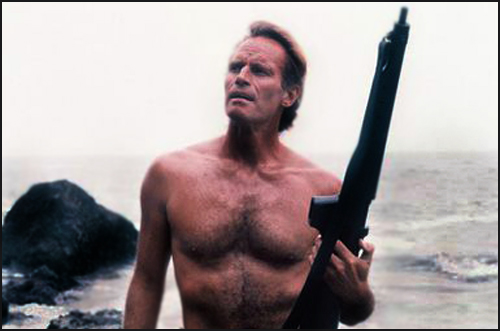
As eminent Victorian and martyr-in-waiting Charles “Chinese” Gordon in Khartoum (1966), our man out-points Laurence Olivier in their two scenes together (Of course the Englishman is acting in something perilously close to brownface as the Mahdi). The film benefits from a screenplay by Robert Ardrey that badly but becomingly wants to be Robert Bolt’s for Lawrence of Arabia, and Ardrey, the then-notorious author of African Genesis: A Personal Investigation into the Animal Origins and Nature of Man (1961) is almost as much of a presence in two 1969 movies that he didn’t write, 2001: A Space Odyssey, and Planet of the Apes. Let Dr. Zaius preach it for us:
Beware the beast man, for he is the Devil’s spawn. Alone among God’s primates, he kills for sport or lust or greed. Yea, he will murder his brother to possess his brother’s land. Let him not breed in great numbers, for he will make a desert of his home, and yours. Shun him, for he is the harbinger of death.
African Genesis and its follow-up The Territorial Imperative: A Personal Inquiry into the Evolutionary Sources of Order and Disorder fell into the disrepute that awaits many if not most popularizers, but recently, with books like Richard Wranghan and Dale Peterson’s Demonic Males: Apes and the Origins of Human Violence (1997) and Craig Stanford’s The Hunting Apes: Meat Eaters and the Origins of Human Behavior (2001), it almost seems as if Ardrey’s ghost is clambering back up out of Olduvai Gorge. Anyway, Wilde once interpreted the 19th century dislike of realism as “the rage of Caliban seeing his face in the mirror,” and apes, as REH showed again and again in his poetry and prose, are the perfect funhouse mirror for reflecting our ineradicable Caliban-ness. The damn dirty ape whose stinking paws we can’t get off of us is us.
The Planet of the Apes series is a politically polymorphous text, one that has been seized upon both by the KKK and those who populate Kleagle nightmares (the studio panicked after test screenings of Conquest of the Planet of the Apes were extremely well received by urban audiences, so the version subsequently distributed was much less, well, riotous). At the risk of being jejune, the first movie is far and away the best, the most resonant, thanks to Rod Serling, director Franklin Schaffner (who’d done The War Lord with Heston in 1965) and the man who brought George Taylor to misanthropic life. This astronaut has the Right Stuff but the Wrong ‘Tude; he’s John Carter with gangrene of the spirit, Pauline Kael’s “perfect American Adam,” but one for whom every Eden is already Sheol. His lack of pride in his own species goeth before a Fall the likes of which he could never have imagined. Heston’s perfect imperfection or imperfect perfection comes not just from his physical attributes but from the fact that he’d been busy incarnating Hegemon Agonistes, what Eric Green, whose seminal Planet of the Apes as American Myth: Race, Politics and Popular Culture (1996) notched a Richard Slotkin introduction, calls “white heroic strength and Western indomitability” in epic after epic, really since The Naked Jungle (1954), in which the swarming, unindividuated, all-destroying Other is army ants rather than the cannon fodder of the Mahdi or the Dowager Empress. Planet‘s roughest of rides for the Heston persona, an enterprise in which the actor was an invaluable and clued-in collaborator, is the hole card that Tim Burton’s 2001 rejiggering could never hope to match.
Linda Harrison’s Nova is arguably the most successful, if dialogue-denied, casting of a producer’s girlfriend as heroine in cinema history, and she might have loosened Heston up during their doomed time together; when we check in with him again postapocalyptically in The Omega Man, his Robert Neville (like Taylor, a colonel) is comparatively funky, enjoying solitary showings of Woodstock and a short-but-sweet relationship with sistah-survivor Rosalind Cash.
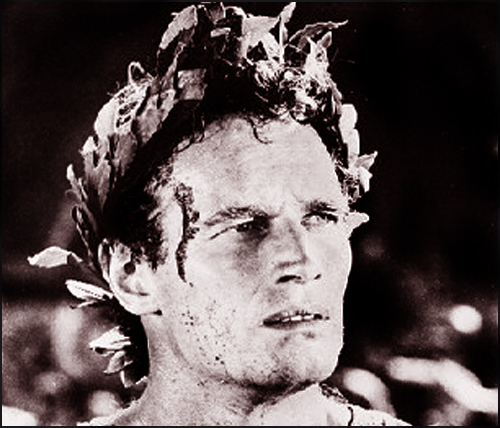
Like, say, Eastwood and Mitchum and Marvin, Heston was an icon of the sort that only our amber waves of grain seem able to produce, but he accepted fewer limits on his “limited range.” As a fledgling-thesp he played Heathcliff, Macbeth, and Petruchio for live television productions, and he would go on to chance his WASPy self in the Irish-American bogs of Eugene O’Neill (A Long Day’s Journey Into Night, with Deborah Kerr). The stages of Heston’s filmography can’t be understood without the stage. Oh, it was great to see him as Sutter Caine’s publisher in John Carpenter’s In the Mouth of Madness (Caine is a Stephen King stand-in, which prompts the melancholy realization that a more Hestonian book mogul would have had the gravitas to tell the real King that at least three hundred pages needed to be trimmed from The Tommyknockers). But it was far greater to see him as The Player King in Kenneth Branagh’s Hamlet (1996). Whether early in his career or late, he reached for the role of Mark Antony (in both Julius Caesar and Antony and Cleopatra) the way others reach for a favorite smoking jacket, and on the evidence of El Cid, would have made a memorable Coriolanus. Shakespeare holds a special place in any overview of Heston’s career; Shakespeare helped give him that career, proffering as the playwright does the keys to the kingdom, to all of the pre-American or un-American kingdoms of “period,” of history and legend. Unlike so many American actors, Heston could be exported from his own place and time, could thrive in contexts like the Book of Exodus, the Paris of Dumas, and the Book of (Simian) Revelations. I hope his Long John Silver and his dying Henry VIII in Richard Fleischer’s Crossed Swords (1977) won’t be forgotten, and it’s a disgrace that The War Lord, set in a twilight realm riven by not only conflict between Norman and Frisian but also that between Christian and pagan, isn’t readily available as a featurette-laden DVD. Had the Jackson/Walsh/Boyens version of Denethor in The Return of the King been more faithful to the Tolkien character–the despair-reduced, Sauron-sapped ruins of a great Numenorean lord–Heston might have been as superbly suited to that role as are Ian McKellen and Christopher Lee to theirs.
The aforementioned Player King signs himself out thusly: “My spirits grow dull, and fain I would beguile/The tedious day with sleep.” When a damnable disease dulled Heston’s spirits, he reacted with considerable grace and dignity, and our day can only be more tedious now that he’s embarked on his last and longest sleep.
